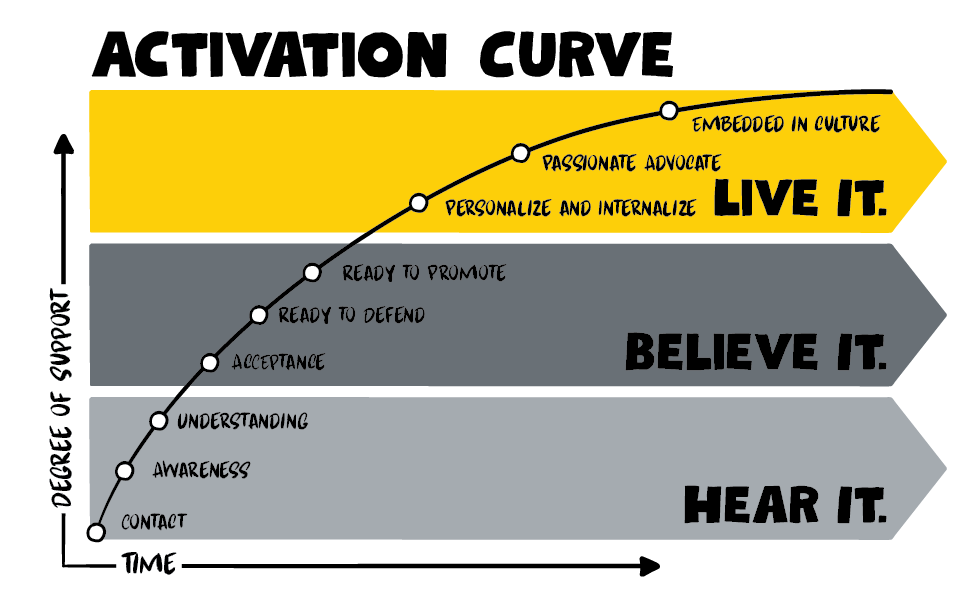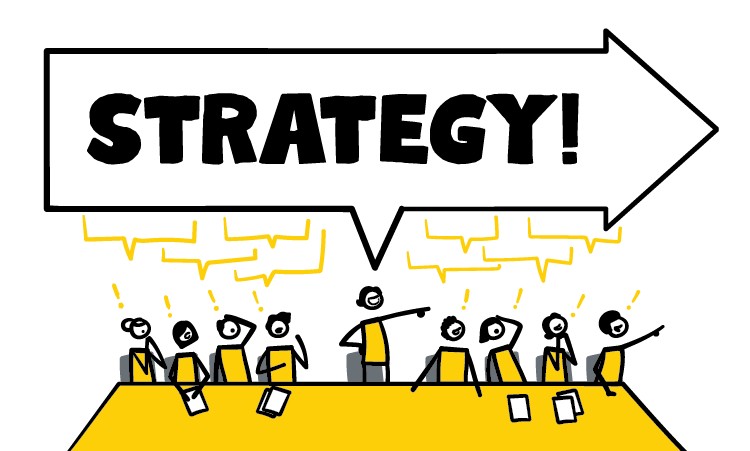In Part 1 of this two-part series on organizational strategy, we defined strategy as a framework for making decisions and dug deeper to distinguish good strategy—which incorporates what, why, and how—from bad strategy, which is long on goals and short on actions.
We also shared a maddening statistic: A full 80% of corporate strategies fail, even though organizations spend a whopping $38 billion dollars annually on strategy consulting.
In Part 2 of this series, we share why so many strategies fail and how you can avoid strategy failure using a few tricks XPLANE has fine-tuned along the way. (HINT: A little fun can go a long way when it comes to getting your strategy off the ground.)
Why do so many corporate strategies fail?
In 25+ years as a design consultancy, we’ve observed two critical turning points that can inspire an organization to new heights or lead to confusion and inaction.
 The Communication Conundrum
The Communication Conundrum
While strategy should bring clarity to an organization, we’ve noticed that leaders and executives traditionally use terribly inadequate and antiquated vehicles to communicate strategy.
Spreadsheets, PowerPoint decks, emails, or worse, “motivational” speeches leave employees confused, stuck, and disengaged.
Why do leaders fall back on these techniques? It often comes down to a lack of understanding just how to translate and incorporate new strategic ideas into daily work routines and tasks.
Implementation Inhibitors
Even when executives do a great job outlining where the company should go, they often fail in follow-through—investing in what it takes to “activate,” or implement, the strategy.
Too often, we see executives delegate implementation to subordinates and let them worry about how to make a strategy happen.
Sometimes, leaders simply assume employees will snap to a new plan once they hear it. But that’s not how we’re wired.
Humans are inherently skeptical. To start changing behavior, we need to hear new information multiple times—and also be convinced that it’s correct and in our best interest.
Different stakeholders in your organization will be at different levels of understanding.
This is the natural result of how human beings process information.
Leaders need to create an implementation plan that moves people up the “Activation Curve,” from hearing a plan, to believing it, to living it.

Make Your Strategy Shine
Fortunately, strategy communication and implementation challenges can be overcome.
Over the years, XPLANE has developed a host of approaches and tools to help organizations get strategies off the ground. While we’ve written extensively on these methodologies and tools, we’d like to highlight a couple ideas here to help you give your strategy some lift and move employees up that activation curve.
 Draw It Out
Draw It Out
If you’ve tried and failed to communicate your strategy with presentations, emails, or CEO messages, drawing pictures instead might help.
Hear me out. At the heart of how XPLANE works is Visual Thinking, which entails communicating through visuals.
According to the dual coding theory by Allan Paivio, when we read text alone, we remember about 10% of the information three days later. When we add relevant images to text, we’re likely to remember 65% of the information three days later.
Visual thinking involves tools and methods that (1) guide senior executives toward alignment, (2) help executives think through implementation, and (3) enable executives to create compelling visual maps and stories that clearly explain the company’s strategy.
When company leaders use visual thinking, employees at every level of the organization better understand where the organization is headed and their role in it.
 Play It Out
Play It Out
Strategy activation relies on alignment and engagement, and we’ve written on better ways to activate your strategy.
Another surprisingly effective way to engage employees is to “play your way” to getting the word out about a new strategy.
XPLANE helped a global logistics company’s management team increase their understanding of the organization’s strategy using a game we helped them develop.
You read that right. A game.
With a new strategy that touched every piece of the business, company leaders knew that successful rollout would be a huge task.
For over a year, XPLANE worked with the company’s internal communications, strategy, and senior leadership teams to gather the right content, build solutions, and test them with a wide audience. Then we created an engaging game experience that could be deployed to 50,000+ employees all around the world.
When we first introduced the game at the company’s annual conference, it became the most popular session of the event.
Created in six different languages and including enterprise strategy learning maps, a physical game board, and a digital game for remote employees, we designed the game to help employees grapple with the tradeoff decisions embedded in the enterprise strategy.
In the end, the game increased understanding of the company’s new strategy by 105%.
Why was it so effective? It was something new and different—and it was fun. Omnidirectional communication techniques like workshops, simulations, role-playing, and even game-playing help employees see the impact of a good strategy in a safe, risk-free environment.
Make Strategy Fun
Whether you’re trying to communicate a strategy or implement a strategy, making your approach fun exponentially increases your chances of success.
Visual thinking and creative design (e.g. game playing) help people relax, think outside the box, see things in a new way, and ultimately become invested in the process—a great start to giving your new strategy wings.
Need help getting your strategy off the ground?
We’d love to help! Send us a note to discuss partnership opportunities.
Interested in learning more about strategy? Here are some XPLANE blog posts we recommend.
